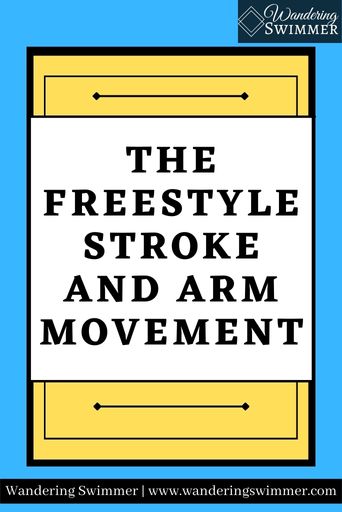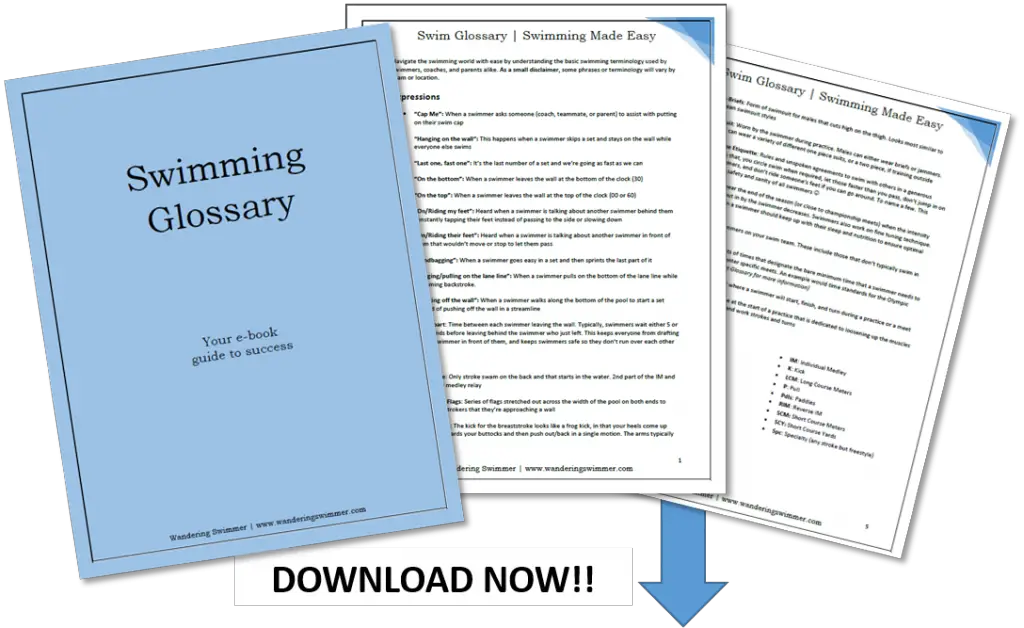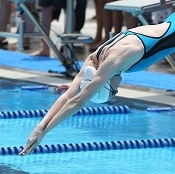In freestyle (also known as the front crawl), the freestyle stroke has a set arm movement that propels swimmers forward.
Understanding and having a good technique for your freestyle stroke will not only help you move forward easier in the water. It will also help avoid shoulder injury, one of the more common injuries in swimming.
Related article: The Beginner’s Guide to Swimming Freestyle
Here’s all you ever wanted to know about the freestyle stroke and arm movement.
Disclosure: This post may contain affiliate links, meaning we earn a small commission at no cost to you if you purchase something through one of our links. As an Amazon Associate, we earn from qualifying purchases. Please check out our disclosure page for more information

The Freestyle Stroke Defined
The freestyle stroke is defined as ‘moving the arms alternately in strokes’. This means that the arms move opposite each other so that when one arm is under the water, the other is above the water.
Because the freestyle stroke is a constant movement between the arms, you will always have one arm pulling the water backward (your propulsion stroke). And another arm moving forward overtop the water (your recovery stroke).
Related article: A Quick Guide to Body Position in Freestyle
Both of these motions work together between the arms and at the same time. And if done correctly, you’ll get some rotation in your hips without even trying!
The motions of the freestyle stroke can be broken up into 6 different pieces or movements, which we’ll list and cover below.
6 Pieces of the Freestyle Stroke
1. Entry
The entry movement of the arm is exactly as the name states 🙂 It’s the motion of the hand entering the water while your arm is extended in front of you. Your hand should be entering almost in line with your shoulder.
During the entry, your palm should be pointed slightly down towards the water and with your thumb angled to enter the water first. The rest of your hand will follow and then the rest of your arm will enter the water.
You shouldn’t be contorting your wrist so that your palm is entering the water followed by the rest of your hand. Nor should you be entering with the pinkie side of your hand.
It’s also important that your hand isn’t cupped like a bowl or a cup during the entry into the water.
More Content for You: 7 Reasons Swimming is So Hard
Yes, your fingers should be together during the freestyle stroke and entry. But your palm should be mostly flat and open.
This is because you will catch and pull more water with a flat palm than with a cupped one!
It probably goes against what your swimming instructors told you way back when but if you watch competitive swimmers, their hands are flat. You can pull more water with a plate than a bowl 🙂
Also, at this stage, your arm is extended out in front of you and your elbow will have a slight bend to it.
2. Catch
Most people don’t realize it but you pull the most water with your forearm compared to your hand. While it’s important to keep your palm flat and open to catch as much water as you can, it’s only an extension of the forearm.
This is because your forearm is much longer and wider than your palm and has more surface area to catch the water as you’re taking each stroke.
More Content for You:
During the catch motion of the freestyle stroke, your forearm is moving down through the water and catches the water with the underside of your forearm.
It’s important that during this process, you’re not bringing your arm down straight down through the water. Instead, your elbow will bend (almost at about a 90-degree angle) and serve as a fulcrum as your forearm moves down and through the water.
Your elbow should be high in the water (but not out of the water) instead of dropping down lower in the water. Keeping it higher in the water allows you to catch the water with your forearm and bring your arm back towards your hip.
As your forearm is pulling down and through the water, you’re moving it back toward your hip. Both your forearm and palm should be facing backward.
Don’t try to twist your shoulder so that you’re pulling with the front of your forearm. This is incredibly hard on your shoulder and you’ll likely injure yourself. Remember that your hand enters palm down and continues that way through the catch.
If you struggle with the catch portion of your freestyle stroke, try using swim paddles such as FINIS Freestyler Paddles. Swim paddles can help improve and guide your freestyle stroke.
3. Pull
In the ‘pull portion’ of the freestyle stroke, your forearm begins to pull the water that it previously caught during the catch. This means that your palm and forearm will be pressing down towards your hip in the water.
Your elbow should remain high in the water and continues to act as a fulcrum so that your upper arm can guide the arm backward. In some ways, the elbow locks into place just enough so it stays bent instead of pulling straight down.
One thing to watch for during this piece of the freestyle stroke is that you don’t cross over. Cross-over happens when your arm reaches over/under the body to the other side. Such as your left arm pulling down to your right hip.
Related article: 10 Drills to Help You Master the Freestyle Stroke
Doing this dips your shoulder deep underwater and your hand gets caught by your hips. And you’re then forced to bring your arm all the way back over to the other side. This takes a lot of energy and time while you’re swimming.
While your arm does pull down and towards your body, it should be a natural movement. Overthinking this motion typically results in swimmers crossing over.
During the pull, your arm will come in slightly to your body by your rib cage and then press back out by your hip. At the same time, your hips are rotating so that the hip is rotated slightly up as your hand is passing it.
4. Exit
As the name suggests, the exit piece of the freestyle stroke is when your hand leaves the water.
Your elbow will leave the water first with your forearm and hand following. Your hand should leave the water down by your hip and should be mostly flat. Keeping it flat helps push the water backward and finishes the stroke.
Finishing the stroke this way instead of stopping just after the pull helps give you just a bit more oomph to push through the water. It can also help some with your rotation.
More Content for You: 8 Best Swim Bags for Swimmers (And Water Enthusiasts)
Make sure you’re not letting your wrist flick as your hand exits the water. It’s a small motion but it causes your forearm to flex more than you think. And after a constant freestyle stroke, it gets tiring.
5. Recovery
The recovery portion of the freestyle stroke happens when the arm is above the water and swinging forward. There are two types of recovery movements that you can see swimmers use, which will be discussed later in this article 🙂
During this stage, your hips will be rotating as your arm is moving forward. Your hip should be rotating forward and down with the arm taking the stroke.
It’s at this stage that you should be finished breathing (if you took your breath) and your head and shoulders are starting to rotate back towards the face-down position
Related article: How to Side-Breathe When Swimming Freestyle
While you’re taking your recovery stroke, keep your palm flat and angled down; the same with your forearm. Don’t twist your shoulder or arm so that your palm and forearm are pointing to the side as you bring your arm around.
This motion can hurt your shoulder and takes additional seconds to twist the arm back into the correct position for the entry.
Instead, the back of your palm and forearm should be angled down as your arm recovers over the water.
We’ll note that while you can recover with your elbow still holding the 90-degree angle with your hand pointing straight down, it may be more comfortable to relax your elbow some. Recovering this way also shortens your stroke, limits your rotation, and can hurt your shoulder.
6. Repeat
And now you’ve come full circle, literally! After your recovery stroke, you’re back to the entry piece of the stroke. At this point, your arm is extended back in front of your body, and will be entering the water once more.
The recovery piece sets up the entry, which is why your hand and forearm must be in the correct position. If you’ve twisted them to the side, you have to twist them back to the proper technique before your hand can enter the water.
Two Types of Recovery
There are at least two types of recovery movements for the freestyle stroke. A high elbow recovery or a low, sweeping stroke.
- High Elbow Recovery: The elbow stays higher above the water throughout the entire recovery and as the hand enters the water, the elbow can be bent more compared to other recovery styles. The recovery motion is guided by the elbow.
- Sweeping Stroke Recovery: In this recovery style, the elbow is bent less and is lower to the water. It’s still above the water but the arm sweeps lower across the water. The recovery motion is guided more by the shoulder
My stroke favors the high elbow recovery even though my college coach tried very hard to get me to switch to the other style of recovery. And while I can do a mix of them, it’s still driven more by the high elbow style.
More Content for You: 8 Best Waterproof Fitness Trackers for Swimming
When it comes to the type of recovery, you should know that there’s no right or wrong style. Every swimmer has a different stroke compared to the next and what works for one swimmer may not work for you.
Instead, you’ll need to play around with your freestyle stroke and recovery to find the style that works best for you.
Getting Down the Timing
Now that you’ve gotten down the technique that comes with the freestyle stroke, you have to tackle the next challenge. Figuring out the timing of the arms and the kick, and how they work together.
It’s easy to focus on one arm at a time. But the freestyle stroke happens when both arms move alternatively of each other. So that when one arm is moving forward, the other arm is pulling backward.
Trying to figure out the timing and rhythm can be frustrating to new swimmers and many tend to overthink it. Truly, the best advice we can give for this is to not overthink it.
As you build and develop your stroke, you’ll find yourself falling into the correct timing without realizing it. Because the arms stroke in opposite mirrors of each other, it’s almost a natural and easy motion to piece together.
Related article: How to Flutter Kick When Swimming Freestyle
The kick itself is also something you shouldn’t overthink. Let yourself kick in a kicking pattern that comes naturally to you; either a two or six-beat kick. At this point, it’s more important to incorporate the flutter kick with your freestyle stroke than avoiding altogether!
Mistakes to Avoid or Watch For
Like with most things in life and swimming, it’s easy to make mistakes. Whether you’re a new swimmer or an experienced one!
A few mistakes to avoid are:
- Entering the water too wide: This happens when your hand enters the water outside your shoulder. Your entry should be in line with your shoulder. If it’s entering wider than your shoulder, you won’t be able to catch and pull the water properly, and your propulsion will be much less
- Too tight of an entry: On the opposite end, you could be entering the water too tight. This will happen when your hand enters the water more in line with your head instead of your shoulder. Or worse, entering in line with the opposite shoulder.
- Pulling straight down: It’s tempting to want to catch and pull with your arm straight down instead of bending your arm, but doing so makes you miss a lot of water. It also makes it a bit more difficult to have an efficient exit
For more mistakes to avoid, be sure to check out our article: 7 Common Freestyle Stroke Mistakes. We go into more depth with these common mistakes and how to correct them!
Freestyle Stroke Tips
Learning to swim the front crawl stroke isn’t without some helpful tips. Try to follow some of the below tips to make the freestyle stroke a bit easier and to help guide you along the way.
- Take your time: As you learn the freestyle stroke, take your time. Don’t start out trying to swim as fast as you can. It takes small and slow steps to understand and master the stroke
- Learn the basics: Along with taking your time, you need to learn the basics as you go. Following the above outline of the freestyle stroke does help. But you should also build into the stroke with progressive drills that help you better develop your stroke.
- Recover: It’s not just a piece of the freestyle stroke! It also means allowing time at the wall to rest and catch your breath. Swimming is challenging and when you’re out of breath, it makes it harder to practice your freestyle stroke
- Watch your stroke: If you can, have someone watch your stroke or video it for you to watch later. You may think you’re doing one thing but you’re doing something else!
- Be patient with yourself: As stated before, swimming is hard. And you won’t learn how to swim overnight. Work breaks into your workout and be happy with the progress you make. It may seem small but small steps still walk you toward the finish line. Or, swim, in this case 😉
In Closing
While the freestyle stroke only has six movements to the stroke, they’re all important and technical. Focusing on proper technique and understanding each piece can help you swim easier and faster. Take your time as you work through learning the freestyle stroke and don’t give up!
As always, happy swimming!
Chevron
Bonus Content
Can You Swim with Bad Eyesight?: Can you swim with bad eyesight? Bad eyesight may limit you from many things, but swimming isn’t one of them! Here are 4 ways to swim with bad vision.
6 Swimsuit Back Styles Explained: How do you pick a back style for you and which is the best one? We’ll break down the 6 swimsuit back styles and explain each one.

Want to Improve at the Pool?
Join swimmers and swim parents to receive my free newsletter and receive a free Swimming Glossary e-book as a thanks!
Every month you’ll receive tips and coaching to help you find success at the pool.
About

Chevron is a current competitive swimmer with almost 20 years of experience in the pool. And although she fell into the sport by accident in her high school years, she still trains daily and competes throughout the year. She’s committed to providing guidance to all levels of swimmers and believes that everyone should know how to swim.